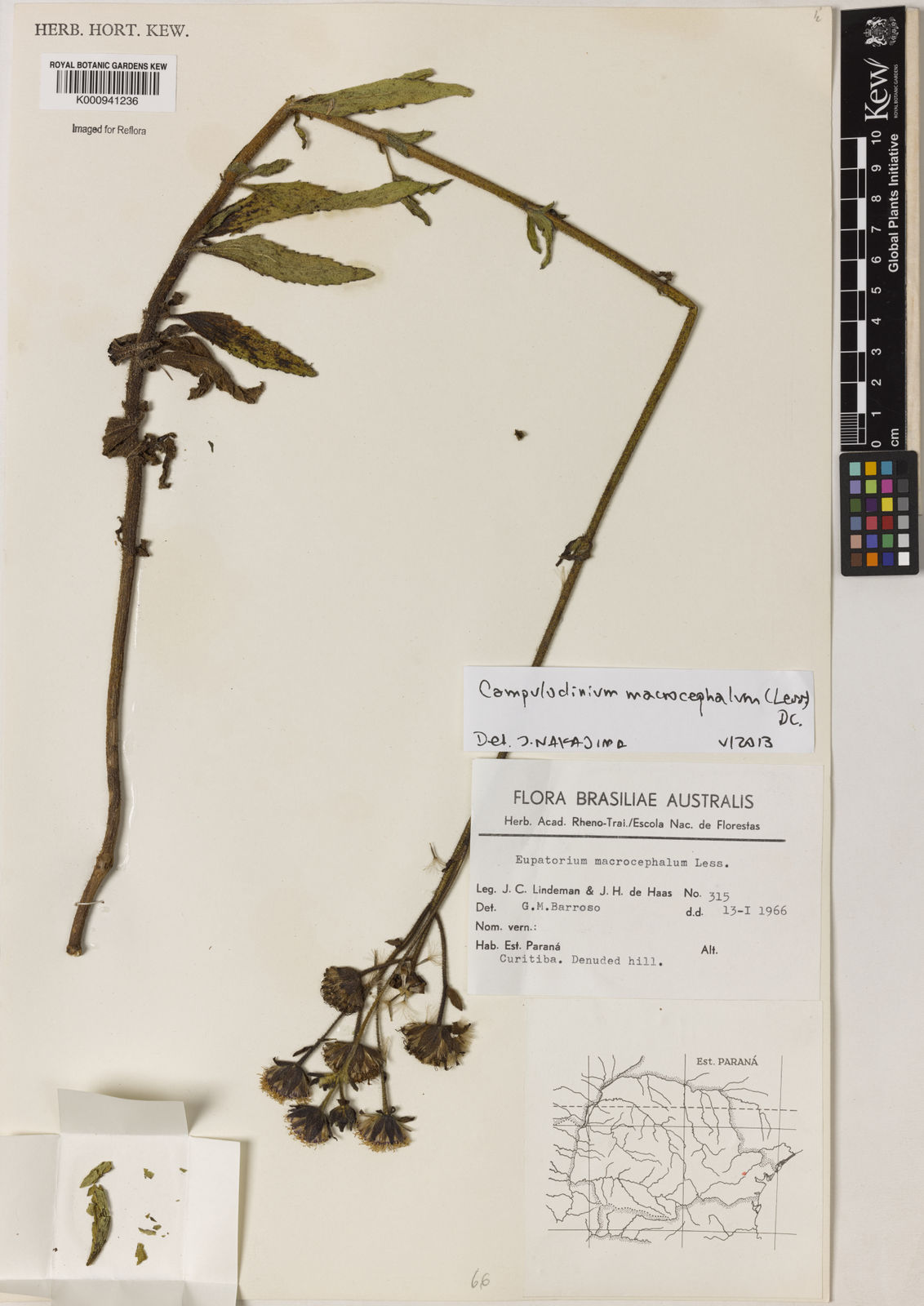Family: Asteraceae
Author: DC.
Bibliography: Prodr. 5: 137 (1836)
Year: 1836
Status: accepted
Rank: species
Genus: Campuloclinium
Vegetable: False
Observations: Mexico to S. Trop. America
Description
Pompomweed, scientifically recognized as Campuloclinium macrocephalum, is a remarkable member of the Asteraceae family. This vibrant plant, first documented by the botanist DC. in Prodr. 5: 137 (1836), paints landscapes with its distinctive, spherical flower clusters that resemble charming pompoms.
Native to a region that spans from Mexico down to South Tropical America, Pompomweed thrives in various climates and environments, contributing to its widespread presence. The plant flourishes in both wild landscapes and cultivated gardens, showcasing its adaptability and hardiness. The resilient nature of Campuloclinium macrocephalum enables it to prosper in a range of altitudes and soil types, making it a familiar sight across its native range.
One of the most striking features of Pompomweed is its inflorescence – the arrangement of flowers on a plant. The plant produces clusters of vibrant, fluffy, and pompom-like flower heads, which are visually captivating and attract a myriad of pollinators, including bees, butterflies, and other insects vital for the ecosystem. The flowers’ striking appearance not only enchants onlookers but also plays a crucial role in promoting biodiversity wherever the plant is found.
Pompomweed’s contribution to its habitat is significant, as it offers nectar and pollen to various pollinators, thereby supporting the local wildlife and maintaining ecological balance. Furthermore, its robust growth can help prevent soil erosion, making it valuable in landscape stabilization and restoration projects.
Despite its benefits, Campuloclinium macrocephalum also has a reputation as an aggressive invader in some regions outside its native range, where it can outcompete local flora and disrupt ecosystems. Thus, while its beauty and ecological contributions are appreciated, managing its spread in non-native areas is essential to protect indigenous plant communities.
In summary, Pompomweed (Campuloclinium macrocephalum) is a striking and adaptable member of the Asteraceae family, celebrated for its unique flower clusters and ecological benefits from Mexico to South Tropical America. Proper management ensures its positive impact on native environments, maintaining its role as a valued plant in its natural habitat.
Common Names
Afr: pom-pom bossie
Eng: pompomweed
En: Pompomweed, Pom-pom weed
Af: Pom-pom bossie, Pompombossie
Synonyms
- Eupatorium stigmatosum (Chodat)
- Eupatorium donianum (Hook. & Arn.)
- Conoclinium macrocephalum ((Less.) DC. ex B.L.Turner)
- Campuloclinium pohlianum (Sch.Bip. ex Baker)
- Eupatorium albertinae (Ant.Molina)
- Eupatorium stigmatosum var. subcalvatum (Chodat)
- Eupatorium stigmatosum var. violaceum (Chodat)
- Campuloclinium strigosum (Sch.Bip. ex Baker)
- Eupatorium macrocephalum var. angustifolium (Baker)
- Campuloclinium macrocephalum var. strigosum (DC.)
- Eupatorium macrocephalum var. stigmatosum (Hassl.)
- Eupatorium oxyhedrum (Baker)
- Eupatorium macrocephalum var. strigosum ((DC.) Baker)
- Eupatorium sladenianum (S.Moore)
- Chromolaena pratensis (Gardner)
- Eupatorium denudatum (Chodat)
- Eupatorium macrocephalum (Less.)
Distribution
- Argentina Northeast (native)
- Argentina Northwest (native)
- Bolivia (native)
- Brazil North (native)
- Brazil Northeast (native)
- Brazil South (native)
- Brazil Southeast (native)
- Brazil West-Central (native)
- Colombia (native)
- Costa Rica (native)
- Guatemala (native)
- Honduras (native)
- Mexico Gulf (native)
- Mexico Northeast (native)
- Mexico Southeast (native)
- Paraguay (native)
- Uruguay (native)
- Venezuela (native)
- Free State (introduced)
- KwaZulu-Natal (introduced)
- Northern Provinces (introduced)
Additional Images
Habit
Taken May 4, 2022 by Muzzachiodi Norberto (cc-by-sa)
Taken Jul 21, 2021 by Trap Hers (cc-by-sa)
Taken Dec 25, 2021 by Trap Hers (cc-by-sa)
Leaf
Taken Apr 25, 2022 by Gonçalves da Cunha Lucas (cc-by-sa)
Taken May 4, 2022 by Muzzachiodi Norberto (cc-by-sa)
Taken Mar 11, 2022 by Zilli Valtair Zilli (cc-by-sa)
Taken Jul 21, 2021 by Trap Hers (cc-by-sa)
Taken Dec 25, 2021 by Trap Hers (cc-by-sa)
Flower
Taken Jun 28, 2022 by Christian renbee (cc-by-sa)
Taken Dec 8, 2021 by osvaldo nohl (cc-by-sa)
Taken Dec 25, 2021 by Trap Hers (cc-by-sa)
Taken Dec 25, 2021 by Trap Hers (cc-by-sa)
Taken Dec 20, 2021 by An Ani (cc-by-sa)
Bark
Taken Apr 25, 2022 by Gonçalves da Cunha Lucas (cc-by-sa)

© copyright of the Board of Trustees of the Royal Botanic Gardens, Kew.
Sources
- WFO (No URL)
- IPNI (No URL)
- GBIF (https://www.gbif.org/species/3142398)
- POWO (http://powo.science.kew.org/taxon/urn:lsid:ipni.org:names:188196-1)
- PlantNet (https://identify.plantnet.org/species/the-plant-list/Campuloclinium macrocephalum (Less.) DC.)














